Common Problems
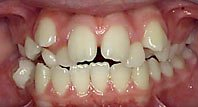
Crowding: Teeth may be aligned poorly because the dental arch is small and/or the teeth are large. The bone and gums over the roots of extremely crowded teeth may become thin and recede as a result of severe crowding. Impacted teeth (teeth that should have come in, but have not), poor biting relationships and undesirable appearance may all result from crowding.
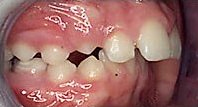
Overjet or protruding upper teeth: Upper front teeth that protrude beyond normal contact with the lower front teeth are prone to injury, often indicate a poor bite of the back teeth (molars), and may indicate an unevenness in jaw growth. Commonly, protruded upper teeth are associated with a lower jaw that is short in proportion to the upper jaw. Thumb and finger sucking habits can also cause a protrusion of the upper incisor teeth.
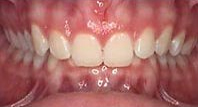
Deep overbite: A deep overbite or deep bite occurs when the lower incisor (front) teeth bite too close or into the gum tissue behind the upper teeth. When the lower front teeth bite into the palate or gum tissue behind the upper front teeth, significant bone damage and discomfort can occur. A deep bite can also contribute to excessive wear of the upper incisor teeth.
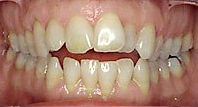
Open bite: An open bite results when the upper and lower incisor teeth do not touch when biting down. This open space between the upper and lower front teeth causes all the chewing pressure to be placed on the back teeth. This excessive biting pressure and rubbing together of the back teeth makes chewing less efficient and may contribute to significant tooth wear.
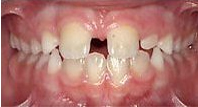
Spacing: If teeth are missing or small, or the dental arch is very wide, space between the teeth can occur. The most common complaint from those with excessive space is poor appearance.
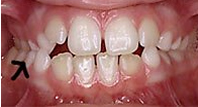
Crossbite: The most common type of a crossbite is when the upper teeth bite inside the lower teeth (toward the tongue). Crossbites of both back teeth and front teeth are commonly corrected early due to biting and chewing difficulties.
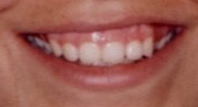
Gummy Smile: A "gummy smile," or excess gingival display, is a condition where too much pink tissue can be seen when a person speaks or smiles. Approximately 7% of men and 14% of women have excess gingival display in full smile. A gummy smile is usually associated with an enlarged upper jaw, a short upper lip, short upper front teeth, or a forward position of the front teeth. This condition may also result from disproportionate lip length or tooth height. A gummy smile can be corrected by orthodontic treatment, periodontal surgery, jaw surgery, or a combination of these procedures. In general, active treatment time with orthodontic appliances ranges from 1 to 2 years. The actual time depends on the growth of the patient's mouth and face, the cooperation of the patient, and the severity of the problem.
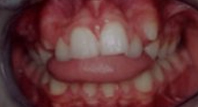
Tongue Thrusting: Swallowing occurs 24 hours per day and about 2000 times each day. Each time you swallow, one to six pounds of pressure is applied to the inside structures of the mouth. Normally when a person swallows, the middle section of the tongue is placed on the roof of the mouth. When the tongue is placed between and behind the teeth, this pressure pushes the teeth apart and out, causing distortions of the face and teeth. This abnormal swallowing motion is known as "tongue thrust." This condition is most common in adolescents or adults and can be corrected with orthodontic treatment.
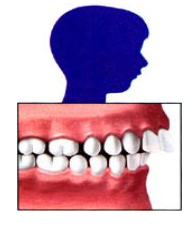
CLASS II:
Class II problems represent abnormal bite relationships in which the upper jaw and its teeth are located in front of the lower jaw. This causes "buck teeth" or "rabbit teeth". In most cases, this relationship is caused by a skeletal malocclusion and is due to inherited characteristics.
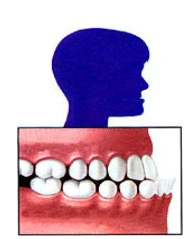
CLASS III:
Class III problems commonly called an under bite are also primarily genetic in origin. In this instance, the lower jaw and teeth are positioned in the front of the upper jaw structures. The facial appearance may give the impression that the lower jaw is excessively large, but in many cases the lack of upper jaw development is at fault. This can cause the lower front teeth to protrude ahead of the upper front teeth creating a crossbite. During treatment , careful monitoring of jaw growth and tooth development is indicated for these patients.
What Can Happen If Malocclusions Are Not Treated?
According to studies by the American Association of Orthodontists, untreated malocclusions may result in a variety of problems. Crowded teeth are more difficult to properly brush and floss which contributes to tooth decay as well as gum disease. Protruding teeth are more susceptible to accidental chipping from trauma. Crossbites can result in unfavorable growth patterns and uneven tooth wear. Openbites can result in tongue thrusting habits and speech issues. Unwanted effects of malocclusions on the psychological situation of the patients must be considered also.








